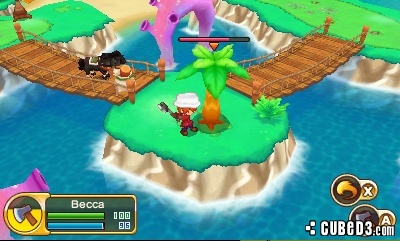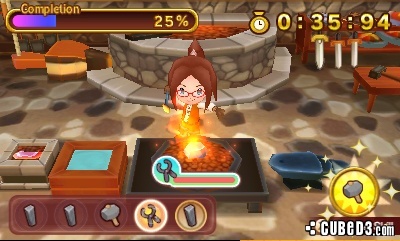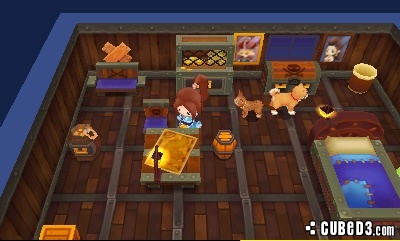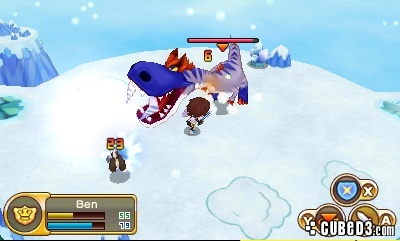Fantasy Life (Nintendo 3DS) Review
By Michael Vondung  27.10.2014
27.10.2014

Level 5, the studio responsible for gems like Dragon Quest IX, Jeanne d'Arc, the Professor Layton games, and the Inazuma Eleven series, is back with a new and exciting franchise: Fantasy Life. Labelled as a "life simulator" with RPG elements, it attempts to appeal to a wide audience of gamers. Surprisingly, it succeeds at avoiding being a master of none, and offers a deeply satisfying and varied experience.
Role-playing games come in all shapes and forms. The more traditional ones are fairly linear and funnel the player through a story whose outcome sometimes, though not always, depends on the choices made on behalf of the character. On the opposite end of the spectrum are the RPGs that offer complete control over everything, including coming up with objectives and a personal plot. Fantasy Life falls in the middle, leaning slightly to the "do whatever you enjoy" side of game design, and also embraces features commonly found in simulators of various types.
Reveria's newest citizen embarks on the Fantasy Life by choosing one of twelve different "lives." This is just a fancy term for what other games call "classes" or "jobs," though it goes slightly beyond this. Lives fall into one of three categories: combat, crafting, and gathering. Unlike in most RPGs, it doesn't actually matter what the player picks at the onset of the adventure. The choice is only relevant for the tutorial and can be changed immediately after. This is refreshing, because it removes all need for fretting over picking the "right" class. Not only that, but there is also zero danger of having to restart later. Fantasy Life is one of the rare games where it is impossible to irreparably mess up one's treasured character.
The tutorial starts off the story, which at first will resemble almost every other JRPG. "Oh, you woke up! It's your first day, so present yourself to the king!" The usual opening spin that everyone has seen plenty of times. If the player went with a combat life -- namely paladin, mercenary, hunter, or magician -- the introduction to the game will continue to seem familiar. If the choice fell on one of the crafting lives, however, the differences become more obvious sooner.
While slaying monsters and completing challenges is certainly an important part of Fantasy Life, the game equally supports alternative playstyles where the video gaming escapist focuses on collecting materials and crafting hundreds of different items that are available. These include a large selection of armours and weapons, clothes, and tools, potions, stats-enhancing food, and furniture that can be used to decorate one of the multiple houses that can be purchased, and simultaneously owned, by the aspiring hero. Crafting requires raw materials or components created by other crafting professions, which are then turned into finished products (or materials for other jobs).

By now it is becoming obvious that Fantasy Life borrows elements from other life simulations such as Animal Crossing (not as many) and Rune Factory (quite a few), and this raises the question how well the game pulls this off without the demand to trade materials or gear with others in what is chiefly meant to be a solo experience. While it is entirely possible to finish the game's story, and even the DLC content, with just one life (many materials and equipment pieces can be purchased from NPCs), one of the core features of Fantasy Life is the ability to change the character's professional hat at the flick of the stylus.
Doing so is entirely trivial, and much easier than a career change would be in real life. All it takes to slip into a different life is a visit at the Guild Office. If it's the first time a new profession is chosen, the game offers a short quest that introduces the job in form of a mini plot. These tutorials are optional, but highly recommend, if only for the extra bit of story that they provide. If someone doesn't really care for that and just wants to grab the profession's license and then get on with virtual life, sitting through the sub-tutorials is not required.
Right here the game may start to sound a tad tedious, seemingly requiring constant job changes. The good news, then, is that it is not necessary to switch to, say, miner whenever there's need for ingots, or woodcutter just to stock up on lumber. Once a license is obtained, the character can gather materials from the respawning nodes regardless of the "active" life. In practice, this means that it's perfectly possible to explore the story and the entire post game, which includes a whole new island if the DLC is purchased, as a "traditional" combat character, and still harvest every rock or tree on the way.
What crafting and gathering lives do provide when they are active, are an occupational bonus (a higher level of the respective skill) and, in case of gathering, an increased amount of harvested materials. For extended crafting sessions, it's a good idea to stop by at the Guild Office to quickly change jobs, just because it's easier to create high quality items with the extra bonuses that come from being in the appropriate life, but it's not disruptive or something that needs to be done every few minutes of playing the game.
Crafting in Fantasy Life consists of reaction-based mini-games. Depending on the profession, the objective is to quickly move between different "workbenches" and perform the appropriate task: timed button mashing, frantic as-fast-as-you-can button mashing, and holding the button down at the right time. Tools, which can also be crafted in different qualities, provide bonuses, as do the relevant stat points. The mini-games get more difficult at higher ranks, but stay fundamentally the same throughout. This can feel a bit repetitive, though with enough practice the player can unlock modes for bulk and automatic creating of often crafted items.

Flexibility and customisation are characteristic features of Fantasy Life. The large number of appearance and cosmetic options, including numerous armour and clothing choices (all of which are shown right on the character model), the complete freedom to play as, and level up, any or all of the twelve "lives," the ease of doing whatever and going wherever desired, the post-story possibility of resetting the character's stats, and the openness of the world invite and encourage anyone to play exactly the kind of game that they're in the mood for at a given time without ever getting hopelessly locked into previous choices.
Even the story is advanced only at the player's discretion. The plot continues when all "requests" from the narrating NPC have been completed (usually small things such as visiting certain places or speaking to specific characters). Story transitions are linear and only slightly more interactive than cut-scenes would be. For some gamers, they might be a little lengthy (some exceed an hour per segment), but save points are plentiful and available even during story portions.
The plot itself is whimsical and friendly. Those looking for a complex, unpredictable, intriguing or even dramatic story won't find it in Fantasy Life. It just isn't that type of the game. This doesn't make the story terrible -- it's indeed quite touching at times -- but it's not the focus. Character progression, the crafting mini-games, gearing up, exploration, reaching the highest rank for each life (there's a party with a unique song when the player masters each life!), running errands for NPCs, and completing challenges are in the centre, and the game implements all of them superbly.
Unlike somewhat related games, such as Harvest Moon, Fantasy Life has a solid combat system that vaguely resembles that of modern Zelda titles, and it does it better than Rune Factory. Combat occurs directly on the "main map," there's no zooming into the action, and all enemies are visible. A little like in the Diablo games, including random loot that drops on the ground, encounters are in real-time and there are no turns. Each combat life has a small number of different skills (or spells, in case of the magician) plus auto-attacks that don't cost steadily replenishing Spell Points (SP). Crafting or gathering lives fight with daggers, if sneaking or dashing around monsters doesn't pan out.
It's possible and desirable to actively block enemy attacks, if a shield is available, or to dodge by manually side-stepping incoming blows. Most damage is avoidable if paid attention to. With the right gear (the best gear is craftable), nothing will seem too challenging, and there's always the pouch, which allows quick shortcuts to quaffing a helpful potion if in a pinch. All in all, combat in Fantasy Life is a little simplistic, straight-forward, and not overly twitchy. It won't cause frustration or reloading (there are no real death penalties, anyway), but sleeping through the more difficult encounters won't quite do, either.

If all of this sounds a bit (or a lot!) like a MMO, then yes, that impression is spot on. Fantasy Life shares much with MMOs, including respawning monsters and resources, the ability to "respec" (reset the stats of) one's character, and the openness of the world. Nothing can be missed. There are two major differences, however: There are no other people ruining the gaming experience, and being online isn't required. In this regard, and most others, Fantasy Life is akin to Skyrim. An admittedly very cute-looking and friendly Skyrim void of any blood and gore, but fundamentally similarly designed nonetheless.
The game does, however, have a multiplayer mode where up to three friends can play together (except for the story missions), so playing with buddies is possible, but entirely optional. North American, Australian, and European game owners can play together, though the Japanese version is incompatible with the Western releases. The one downside here is that the potential co-op partners must be on one's friends list, and either all or none of the participants must have the DLC.
Those who prefer to play alone can team up with a sizeable number of NPCs (unlocked during the story mode), up to two at a time, and nameable pets that are happy to come along for the trip. The more adventures they share with the player's character, the higher their friendship rating (DLC) becomes and the better they perform in combat. NPC companions include healers, ranged attackers, melee fighters, and tanks. The AI is not as bad as one might expect, and certainly doesn't perform worse than random group members in MMOs (and they don't whine!).
Finally, Fantasy Life comes with day-one DLC that is already on the cartridge or included in the eShop download. This is a bit of a turn-off, because even though the DLC was released in Japan months after the game, it still feels like it was deliberately cut out of the game so that the content could be sold separately. In spite of this, the DLC adds so much content that it is highly recommended, even if supporting day-one DLC might feel completely wrong.
The friendship system, a whole new island, higher level cap, additional ranks for lives, more recipes and items, another house, and plenty of fresh recipes really enhance the Fantasy Life experience. It should have been in the game at no charge, but for how much it offers, it's still a good deal. It can be picked up later also, so checking out the game before handing over more cash is not a bad approach. Eventually, though, anyone thoroughly enjoying Fantasy Life will want the extra content.

Cubed3 Rating
Great - Silver Award

An ambitious game like Fantasy Life that tries to do it all runs the risk of drowning itself in mediocrity. It is no small feat of Level 5's designers to have successfully bypassed the pitfalls that similar games stepped into. They birthed an original, addictive RPG that does so much right. The game isn't flawless, but its shortcomings are on a high level and chiefly in relation to itself. Sure, the crafting mini-games could be more varied, but they are a huge step up from the "click a button and walk away" afk-crafting that most other games feature. Combat could be deeper, but it's still superior to anything comparable titles offer. Perhaps a couple of extra jobs, such as farming, would have been great, but having 12 classes, all interwoven with one another and yet fully functional on their own, dwarves the competition. Fans of life simulators, crafting games, and dungeon crawlers alike will find much here to love and get lost in. An impressive debut for a brand-new IP whose clever and well thought out design catapults Fantasy Life into the upper ranks of the 3DS library.

![]() 8/10
8/10
![]() 8/10
(3 Votes)
8/10
(3 Votes)
 Out now
Out now  Out now
Out now  Out now
Out now  Out now Also on
Out now Also on 
Comments
Comments are currently disabled

 Sign In
Sign In Game Details
Game Details Subscribe to this topic
Subscribe to this topic Features
Features





 Top
Top

